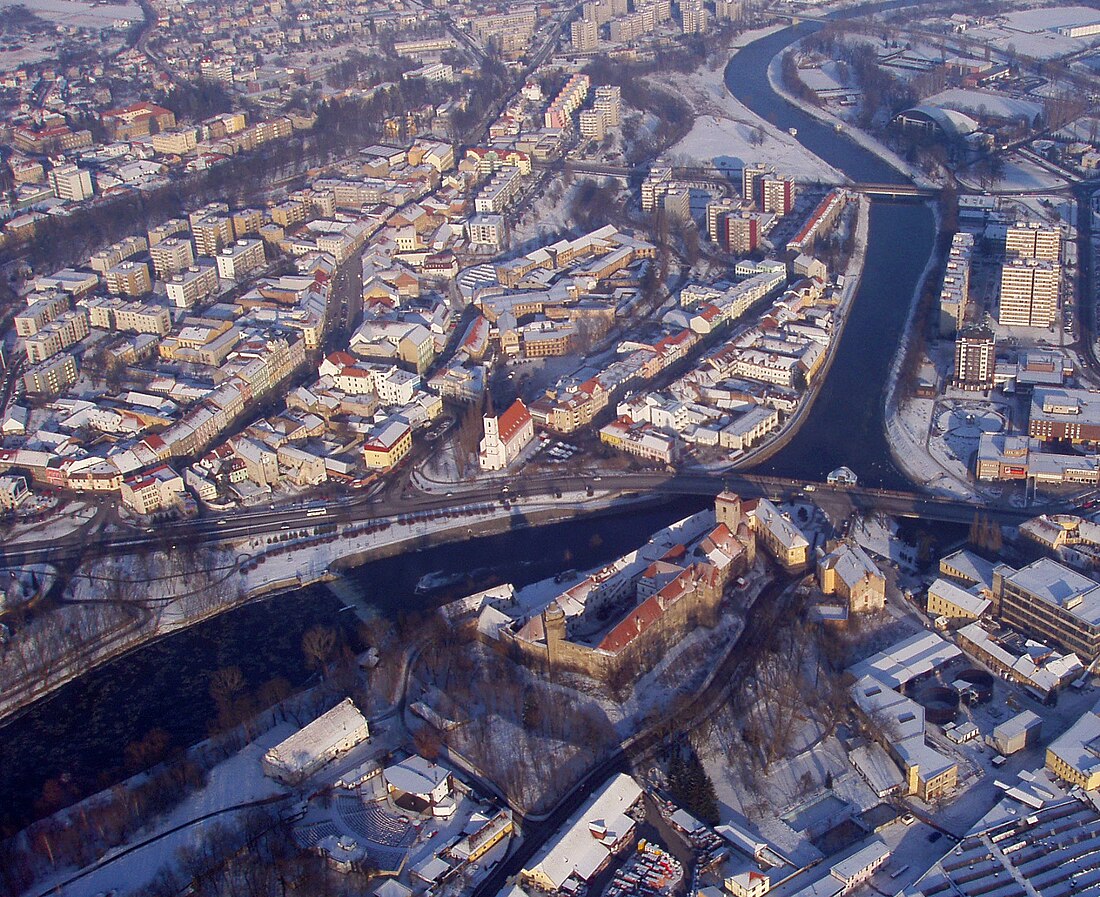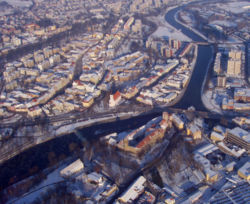Top Qs
Timeline
Chat
Perspective
Strakonice
Town in Czech Republic From Wikipedia, the free encyclopedia
Remove ads
Strakonice (Czech pronunciation: [ˈstrakoɲɪtsɛ]; German: Strakonitz) is a town in the South Bohemian Region of the Czech Republic. It has about 22,000 inhabitants and is located at the confluence of the Volyňka and Otava rivers. The feudal history of the town was linked particularly to the order of Knights Hospitaller. The main landmark of the town is the Strakonice Castle, protected as a national cultural monument. The historic character of Strakonice was disrupted in the 20th century and today the town's economy is focused mainly on industrial production.
Remove ads
Administrative division
Strakonice consists of eight municipal parts (in brackets population according to the 2021 census):[2]
- Strakonice I (13,395)
- Strakonice II (4,527)
- Dražejov (1,384)
- Hajská (63)
- Modlešovice (188)
- Přední Ptákovice (2,190)
- Střela (85)
- Virt (77)
Etymology
The town's name is derived from the personal name Strakoň, meaning "the village of Strakoň's people".[3]
Geography
Summarize
Perspective
Strakonice is located about 51 kilometres (32 mi) northwest of České Budějovice. It lies mostly in the northern tip of the České Budějovice Basin, but the municipal territory also extends to the Blatná Uplands on the north and to the Bohemian Forest Foothills on the south. The highest point is the hill Velká Kakada at 564 m (1,850 ft) above sea level, located in the southern part of Strakonice's territory.
The town is situated at the confluence of the Volyňka and Otava rivers. There are several fishponds in the area, the largest of which are Velkoholský rybník and Blatský rybník. Among the small-scale protected areas in Strakonice are Bažantnice u Pracejovic Nature Reserve and the Tůně u Hajské Nature Monument.
Climate
Strakonice has a cool, wet, and temperate inland variant of the humid continental climate (Dfb).
History

A moated castle on the Otava River was built by the noble family Bavors of Strakonice at the beginning of the 13th century. The first written mention of the castle is from 1235. The first written mention of the village of Strakonice is from 1243, when the Church of Saint Wenceslaus already existed and the Bavors donated part of the castle and several villages in its vicinity to Knights Hospitaller of the Order of Saint John. In 1318, Strakonice was already a town.[5][6]
From 1402 on, the Knights Hospitaller owned the entire castle, including the town, as well as the surrounding estate.[6] In 1420, Jan Žižka, the Hussite commander, occupied Strakonice, but failed to capture the castle. Strakonice Castle underwent an extensive remodel in the 16th century and became a representative residence of the Grand Priors of the Order. Subsequent alterations were only minor. After the Thirty Years' War, the castle lost its significance.[5][6]
The town was industrialised during the course of the 19th century. In the 1860s, a railway line from České Budějovice to Plzeň via Strakonice was built, which helped its economic development.[5]
Remove ads
Demographics
Strakonice experienced its greatest population growth between 1950 and 1980, when the town's population nearly doubled as a result of further industrialisation, particularly at Česká zbrojovka Strakonice and Fezko. The consolidation of agriculture and rapid urbanisation during the communist era helped make Strakonice one the fastest growing towns in the region.[7]
Remove ads
Economy

Strakonice is known for fez hat manufacture that dates back to the 19th century, and it has established itself as a small arms and motorbike manufacturing hub. Along with České Budějovice, Tábor, and Písek, Strakonice is considered one of the main industrial centres of South Bohemia.[7]
Strakonice is also known for its brewery called "Dudák – Burghers' Brewery Strakonice", located near the castle. It produces beer under the Strakonický Dudák brand. The brewery is owned by the municipality, the last one of its kind in the Czech Republic.[10] The beer brewing tradition in Strakonice dates back to 1367 and Burghers' Brewery was founded in 1649.[11]
Remove ads
Transport

Two main roads pass through Strakonice: the I/4 road, which connects the D4 motorway with the Czech-German border in Strážný, and the I/22 road in the section from Klatovy to Vodňany.
A railway line of national importance from Brno to Plzeň via České Budějovice passes through Strakonice. Railway lines to Beroun, Milevsko, Blatná and Volary originate in Strakonice.[12]
Remove ads
Culture

Every year, the town hosts the International Bagpipe Festival. The town's bagpipe tradition goes back to the work of Josef Kajetán Tyl Strakonický dudák ("The Bagpiper of Strakonice").[13] The festival has been held since 1967 and is one of the most notable folklore festivals in the world.[14]
Sights
Most of Strakonice's historic building stock was demolished during the 20th century. The Strakonice Castle is the most valuable monument, protected as a national cultural monument.[15] It now serves as a regional museum and art gallery. Its exhibitions focus on motorcycles, small arms, bagpipes and the traditional fez hat production. The Rumpál Tower serves as a lookout.[16] Part of the castle complex is the Church of Saint Procopius. It was originally a Romanesque building, which was later rebuilt in Baroque style with Rococo elements.[17]
The Church of Saint Margaret was built in 1580–1583, in the late Gothic style with many Renaissance elements. Baroque modifications were incorporated in 1777. It is one of the main landmarks of the town centre.[18]
The Church of Saint Wenceslaus was originally a medieval Gothic church, founded in the 1300s. It was rebuilt in the Baroque style in 1720–1730 and serves as a cemetery church.[19]
The Church of the Virgin Mary is a pilgrimage site located in Přední Ptákovice. It was built in 1771–1774, when it replaced a chapel that dated back to 1749.[20]
Gallery
- Strakonice Castle
- Rumpál Tower
- Church of Saint Procopius
- Church of Saint Margaret
- Church of Saint Wenceslaus
- Church of the Virgin Mary in Ptákovice
Notable people
- Jan Antonín Losy (c. 1650–1721), lute player and composer
- František Čelakovský (1799–1852), writer and translator
- Martin Mathias Secor (1841–1911), American businessman
- Leopold Ehrmann (1886–1951), architect
- Riccardo Pick-Mangiagalli (1882–1949), Italian composer
- Xena Longenová (1891–1928), actress
- Josef Skupa (1892–1957), puppeteer
- Věra Machoninová (born 1928), architect
- Marie Poledňáková (1941–2022), film director
- Pavel Pavel (born 1957), engineer and experimental archaeologist
- Roman Turek (born 1970), ice hockey player
- Alexander Salák (born 1987), ice hockey player
- Zdeněk Ondrášek (born 1988), footballer
- Jindřich Staněk (born 1996), footballer
- Vít Krejčí (born 2000), basketball player
Remove ads
Twin towns – sister cities
Strakonice is twinned with:[21]
 Bad Salzungen, Germany
Bad Salzungen, Germany Calderdale, England, United Kingdom
Calderdale, England, United Kingdom Lengnau, Switzerland
Lengnau, Switzerland
Strakonice also has friendly relations with Rawicz in Poland.[21]
References
External links
Wikiwand - on
Seamless Wikipedia browsing. On steroids.
Remove ads










